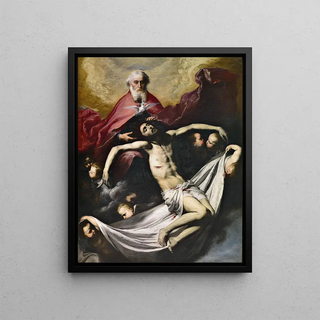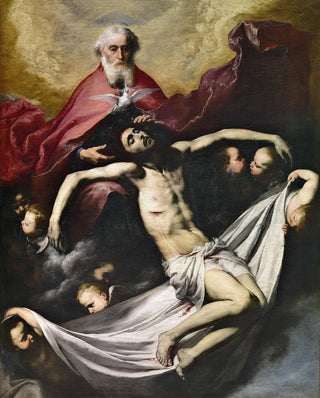Art print | La Trinité - Jusepe de Ribera


View from behind

Frame (optional)
In the fascinating world of baroque art, "The Trinity" by Jusepe de Ribera stands out as an iconic masterpiece, revealing the depth of Christian spirituality through a rich palette of colors and unparalleled technical mastery. This painting, which evokes strong emotion, invites the viewer to meditative contemplation while illustrating the power of faith. The depiction of the Trinity, a central concept in Christian theology, is interpreted here with dramatic intensity, showcasing Ribera's exceptional talent. Light, movement, and the expression of the figures intertwine to create a vibrant scene where every detail matters, capturing the very essence of divinity.
Style and uniqueness of the work
Ribera's style is characterized by its striking realism and bold use of light and shadow, a technique known as chiaroscuro. In "The Trinity," the figures are rendered with anatomical precision that gives the scene an almost palpable vitality. The drapery of the garments, heavy and textured, contrasts with the softness of the faces, creating a visual tension that draws the eye. The composition, carefully balanced, directs attention toward the center of the piece, where the figures of the Father, the Son, and the Holy Spirit converge in divine harmony. This unique approach, blending realism and spirituality, makes Ribera a pioneer of his time, capable of transcending the simple act of painting to offer an immersive and transcendent experience.
The artist and his influence
Jusepe de Ribera, born in Spain and having spent much of his life in Italy, established himself as one of the masters of baroque. His training in Naples, in contact with the great figures of the movement, allowed him to develop a distinctive style that combines the rigor of drawing with emotional expressiveness. Ribera draws inspiration from the works of the Caravaggisti, but he manages to forge a unique identity, marked by an heightened sensitivity to the human condition. His influence extends far beyond his era, inspiring generations of artists, from romantic painting to realism.

Matte finish

View from behind

Frame (optional)
In the fascinating world of baroque art, "The Trinity" by Jusepe de Ribera stands out as an iconic masterpiece, revealing the depth of Christian spirituality through a rich palette of colors and unparalleled technical mastery. This painting, which evokes strong emotion, invites the viewer to meditative contemplation while illustrating the power of faith. The depiction of the Trinity, a central concept in Christian theology, is interpreted here with dramatic intensity, showcasing Ribera's exceptional talent. Light, movement, and the expression of the figures intertwine to create a vibrant scene where every detail matters, capturing the very essence of divinity.
Style and uniqueness of the work
Ribera's style is characterized by its striking realism and bold use of light and shadow, a technique known as chiaroscuro. In "The Trinity," the figures are rendered with anatomical precision that gives the scene an almost palpable vitality. The drapery of the garments, heavy and textured, contrasts with the softness of the faces, creating a visual tension that draws the eye. The composition, carefully balanced, directs attention toward the center of the piece, where the figures of the Father, the Son, and the Holy Spirit converge in divine harmony. This unique approach, blending realism and spirituality, makes Ribera a pioneer of his time, capable of transcending the simple act of painting to offer an immersive and transcendent experience.
The artist and his influence
Jusepe de Ribera, born in Spain and having spent much of his life in Italy, established himself as one of the masters of baroque. His training in Naples, in contact with the great figures of the movement, allowed him to develop a distinctive style that combines the rigor of drawing with emotional expressiveness. Ribera draws inspiration from the works of the Caravaggisti, but he manages to forge a unique identity, marked by an heightened sensitivity to the human condition. His influence extends far beyond his era, inspiring generations of artists, from romantic painting to realism.






